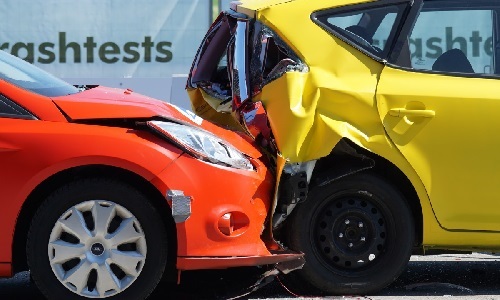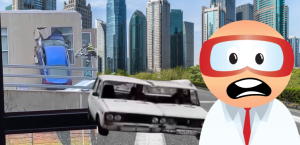By Jeff Sanford
Toronto, Ontario — April 20, 2018 — In today’s Friday Fun: GTA shops are flooded with jobs in wake of ice-storm and year-end stats on 2017 collision numbers.
This past week central Canada was hit with several days of freezing rain and deluges of ice pellets. Around the greater Toronto area drivers seemed to have forgotten how to navigate in bad weather. According to the Ontario Provincial Police (OPP) there were more than 1,600 collisions over the weekend. At the height of the storm one officer said there was an accident occurring every two minutes. Police told drivers involved in accidents to just go home rather than drive to a collision reporting centre. “When we look at all those crashes there is one common denominator. It is not the weather, it is not the roads, it is not the conditions, it is the poor driving of the drivers,” an officer was quoted as saying. During that time police in the GTA also laid 15 criminally impaired driving charges. According to the officer quoted, that’s “completely unacceptable.”
Police also found themselves having to remind drivers to clean off their cars before getting on the road. Considering this is Canada it seems silly to have to remind people of that. But several incidents prompted the warning. Officers posted pictures of several vehicles badly damaged from ice flying off cars. One of the vehicles damaged by ice was the team bus for the Kansas City Royals that was driving into the city for a game against the Toronto Blue Jays. The incident occurred on the eastbound Gardiner Expressway. The bus was travelling under an overpass when ice came off of another vehicle and struck the windshield. “We were the second bus following our coaches and media and staff bus. I don’t know if it was the wind that knocked it off but a huge chunk of ice came off and smoked the front windshield and shattered it,” said one of the players to a reporter. “We didn’t know what the heck was going on until we looked up and saw glass everywhere.” Relief pitcher Blaine Boyer jumped into action and helped out the driver. “He kind of held the wheel a little bit while the driver took a deep breath and got his composure back. Good thing he reacted quickly,” said a teammate. Drivers with ice on the windshield were ticketed for $110.
A Windsor truck driver is facing a careless driving charge after going the wrong way on Highway 401. Elgin County OPP found the truck driver behind the wheel of his full-sized transport truck after it had been travelling west in the eastbound lanes of the 401 near Dutton. Police received multiple reports of the wayward rig around 9:20 AM. When officers found the truck, it was already on a bridge turning around. Police estimate the truck travelled for about a kilometre in the wrong direction. According to the media report, “OPP advise that any motorists who find themselves travelling the wrong way on a major highway should not attempt to turn around. Simply pull over to the closest shoulder and contact police.”
There was more than the normal amount of collision-related stories this week. Several different police divisions and various organizations reported year-end collision stats. Among the reports: “February 2018 was the second worst February in Manitoba for road deaths in two decades, with 14 deaths as a result of crashes on Manitoba roads. This brings the number of Manitobans killed in motor vehicle crashes for the first three months of 2018 to 18, about 80 percent higher than average over the last five years during the same time frame,” according to the public insurer in that province, MPI. The press release also notes that, “further analysis reveals that of the 13 drivers and passengers killed in fatal crashes so far this year, nearly 40 percent were not using a seatbelt at the time of the crash.”
The OPP announced 2017 collision statistics. The numbers were not good. According to the force the province experienced, “a five-year high for the number of fatalities from collisions on roads they patrol in 2017, including a 10-year high for the number of people killed in collisions involving a transport truck.” According to a media report, “343 people died in collisions in 2017 compared to 307 in 2016, with the increase coming from driver inattention, speed and not wearing seatbelts. 91 people died in collisions that involved a commercial transport truck in 2017.” As well, 48 motorcyclists died in 2017 – another 10-year-high – with 27 of those riders not at fault for the collisions. The OPP also said 2017 was, “the deadliest year on record for snowmobile deaths with 29, compared to 16 the year before.” Police say excessive speed, loss of control and driver inattention led the list as primary causes.
Another statistic that was higher than recent years were boating deaths, which reached an eight-year high with 31 people dying last year compared to 23 the year before. OPP Commissioner J.V. Hawkes said he was saddened by the statistics. “As is the case every year, the majority of these deaths were preventable and attributed to poor driving behaviours,” Hawkes said in a press release. “Until all drivers respect and observe road, off-road and marine laws that are designed to keep us all safe, these tragic deaths will continue.”
Also this week: Three separate crashes involving school buses in two days prompted the OPP to issue a warning. In the first case, a sport utility vehicle slammed into the back of a school bus on Highway 17 near Spragge, Ontario. The driver of the SUV died from his injuries but none of the children were seriously hurt. At about the same time Thursday, near West Parry Sound on Highway 141, a school bus collided with a farm tractor and tipped over. Again, no children were hurt. The third collision occurred Friday in Elliot Lake. The collision was described as a minor fender bender. Nevertheless, the OPP issued a warning, “The three bus collisions in a couple of days raised the alarm for us. School’s not done. You need to expect school buses to be on the road during school hours. More importantly, we’re not done winter yet,” said an OPP source.
The OPP detachment in West Nipissing had some good news. The region has experienced a big drop in collisions during the first quarter of the year. Figures from the West Nipissing Police indicate there were 23 collisions from January to March compared to 45 for the same time a year ago. The chief of police suggested that, “road crews that keep roadways clear of snow and ice and drivers being more careful are two reasons for the lower number of collisions. The Chief says failing to yield the right-of-way and improper turns caused most of those collisions.”
There were a couple of other interesting stories from the wider world of “collisions.”
In Singapore, technology firm Fujitsu Limited, Singapore Management University (SMU) and the Institute of High Performance Computing announced that they are collaborating on a new technology for avoiding collisions between ocean going vessels. Singapore is the largest bunkering station in the world (ships fill up with fuel measured by the ‘bunker,’ the amount of oil carried by the small tender vessels that pull up alongside ships to refuel). According to a media report there are about 1,000 vessels in the Port of Singapore port at any given moment. A new vessel arrives or leaves every two to three minutes. To reduce the likelihood of a collision the new technology being developed will use artificial intelligence and big data analysis to predict an upcoming collision and issue an early warning to ship captains.
Even further afield are new efforts to avoid collisions in space. A story in Wired magazine notes there are 23,000 satellites, 650,000 softball-to-fingernail-size objects and 170 million pieces of space junk smaller than the tip of a pen in the atmosphere. This space junk creates the real risk of a collision between with a manned vehicle. According to the story, a collision with a “10-centimetre sphere of aluminum would be akin to detonating 7 kilograms of TNT. Avoiding such catastrophic collisions is vital to ensuring humans can still access space without have their hardware or spaceships whacked by debris.” As privately-funded commercial space travel gets set to boom in the coming years, dealing with all the space junk is becoming a bigger problem. According to the report a piece of space debris has already punched a hole in what was essentially the space shuttle Endeavour’s ‘radiator.’ The U.S. military now relies on the Space Surveillance Network (SSN) to track all the junk. Those involved in avoiding space collisions talk about a, “hypothetical, scientifically plausible, spiralling-out-of-control scenario with space junk called the Kessler syndrome. In a Kessler syndrome event, one collision begets other collisions, and quickly spreads debris in a catastrophic chain-reaction. A Kessler syndrome event could create an Asteroid Belt-like field of debris in large regions of space around Earth. Those zones could wind up being too risky to fly new satellites or spaceships into for hundreds of years, which would severely limit human access to the final frontier,” according to the story. There is now a privately-run company, Exoanalytic, helping out with the tracking of space junk.





































